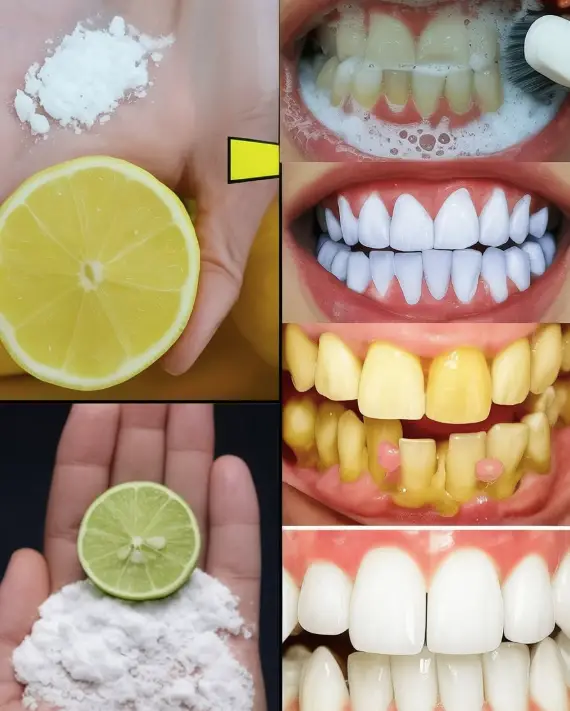A bright, confident smile can light up a room—but dull or stained teeth can make you feel self-conscious. The good news? The secret to a dazzling smile might already be in your kitchen. Baking soda and lemon, two everyday ingredients, have gained popularity for their natural whitening power. Let’s explore how this dynamic duo works, how to use it safely, and what dental experts say about keeping your teeth bright and healthy—without damaging your enamel.
Why Your Smile Matters
Your smile is often the first thing people notice and plays a big role in your confidence. According to the American Dental Association (ADA), nearly 80% of Americans consider oral health essential to overall well-being. Yellowed or stained teeth, often caused by coffee, tea, or aging, can dull your smile’s sparkle. While professional whitening treatments are effective, they can be costly. That’s where natural remedies like baking soda and lemon come in, offering a budget-friendly option when used correctly.
Understanding Baking Soda and Lemon for Teeth Whitening
Baking soda and lemon are celebrated for their natural properties, but how do they help your teeth? Let’s break it down.
The Role of Baking Soda
Baking soda, or sodium bicarbonate, is a mild abrasive that gently scrubs away surface stains on teeth. According to WebMD, its gritty texture helps remove plaque and discoloration caused by food, drinks, or smoking. It also neutralizes acids in the mouth, creating an environment less favorable for bacteria that cause bad breath.
Benefits: Polishes teeth, reduces surface stains, and freshens breath.
How it works: Acts as a gentle exfoliant for enamel and balances oral pH.
The Power of Lemon
Lemon juice contains citric acid, which may help break down stains and brighten teeth. A study in the Journal of Clinical Dentistry notes that citric acid can enhance the whitening effects of abrasive agents like baking soda. Lemon also has antibacterial properties that may support oral hygiene.
Benefits: May lighten stains and contribute to a fresher mouth.
How it works: Citric acid softens stains, making them easier to remove.
How to Use Baking Soda and Lemon Safely
While baking soda and lemon can brighten your smile, it’s important to use them carefully to avoid damaging your enamel. Here’s a step-by-step guide to trying this remedy at home.
What You’ll Need
- Baking soda (food-grade, not cleaning-grade)
- Fresh lemon or bottled lemon juice (fresh is preferred)
- A small bowl and spoon
- A soft-bristled toothbrush
- Water for rinsing
Steps for Teeth Whitening
- Mix the Paste: Combine 1 teaspoon of baking soda with a few drops of lemon juice in a small bowl. Stir until it forms a thick paste. The mixture may fizz slightly due to the reaction between baking soda and lemon’s acid.
- Apply to Teeth: Dip a soft-bristled toothbrush into the paste and gently brush your teeth for 1–2 minutes. Focus on stained areas, but avoid aggressive scrubbing.
- Rinse Thoroughly: Rinse your mouth with water to remove all residue. Follow with regular toothpaste brushing to ensure no acid remains.
- Frequency: Use this mixture no more than once a week to prevent enamel wear. Overuse can weaken enamel, according to the ADA.
Safety Tips
- Limit use to once a week to protect enamel.
- Test for sensitivity before full application and discontinue if discomfort occurs.
- Avoid using if you have open sores or cuts in your mouth, as lemon’s acidity may irritate them.
- Consult a dentist if you have concerns or pre-existing dental issues.
What Experts Say About Natural Whitening
While baking soda and lemon are popular, experts urge caution. The ADA notes that baking soda is safe in small amounts but warns against overusing acidic ingredients like lemon, which can erode enamel over time. A study from Harvard Health suggests natural remedies may complement professional care but shouldn’t replace regular dental visits. For best results, combine this remedy with good oral hygiene, such as brushing twice daily and flossing.
Other natural options, like coconut oil pulling or charcoal toothpaste, may offer benefits, though evidence is limited. Always choose products with the ADA Seal of Acceptance for safety.
Daily Habits for a Brighter Smile
Beyond natural remedies, simple habits support healthy, bright teeth. Here are expert-backed tips from the CDC and Mayo Clinic:
- Brush twice daily with fluoride toothpaste and a soft-bristled brush.
- Floss daily to remove plaque and food debris.
- Limit intake of staining foods and drinks like coffee, tea, and red wine, or rinse your mouth after consuming them.
- Drink plenty of water throughout the day.
- Visit your dentist every six months for professional cleanings and oral health checks.
When to See a Dentist
Natural remedies can help with minor stains but aren’t a cure-all. See a dentist if:
- Stains persist despite home treatments.
- You experience sensitivity, pain, or irritation.
- You suspect cavities, gum disease, or other issues.
- You want professional whitening for faster, safer results.
Professional treatments protect enamel while providing noticeable results. A dentist can also determine if stains are surface-level or deeper, requiring different care.
Boost Your Confidence with a Radiant Smile
A bright smile boosts confidence and can brighten your day. Baking soda and lemon offer a simple, affordable way to enhance your smile at home—when used wisely. Pair this remedy with consistent oral hygiene and regular dental checkups for the best results. Have you tried natural teeth whitening? Share your favorite tips in the comments or pass this article to a friend who loves a sparkling smile.
Disclaimer: This article is for informational purposes only and does not substitute professional medical advice. Consult your doctor or dentist before making health changes.
